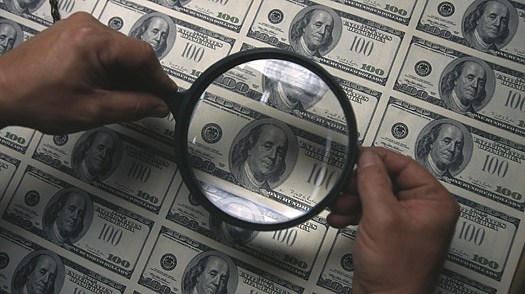 If Internet conversation is any indication, businesses and consumers continue to harbor fears of being swindled by fraudulent dollars. And while federal and state law enforcement places a premium on tracking down counterfeiters to prevent the distribution and use of counterfeit currency, those efforts are of little reassurance to the defrauded victims.
If Internet conversation is any indication, businesses and consumers continue to harbor fears of being swindled by fraudulent dollars. And while federal and state law enforcement places a premium on tracking down counterfeiters to prevent the distribution and use of counterfeit currency, those efforts are of little reassurance to the defrauded victims.
Not only is there no form of restitution available to those who have been paid with fraudulent dollars, but anyone who uses counterfeit money -- whether knowingly or not -- runs the risk of being arrested and charged with counterfeit fraud.
Given this challenge, the best thing businesses can do to protect themselves is to learn how to detect counterfeit money. And while the cheap-and-easy measures can be enticing, they aren't reliable enough to stake your business and reputation on them. To fully protect yourself, more proactive protection is required.
Intaglio Printing
 Intaglio is a basic security feature of U.S. currency that is very difficult to replicate even with professional-grade printing machines. The process creates concentric, ink-filled ridges that extend out from the middle of any bill. These ridges are easily viewed through a loop, but even without a loop you can run your fingers across the face of the bill and feel the roughness of the ridges in contrast to the smooth surface of the bill.
Intaglio is a basic security feature of U.S. currency that is very difficult to replicate even with professional-grade printing machines. The process creates concentric, ink-filled ridges that extend out from the middle of any bill. These ridges are easily viewed through a loop, but even without a loop you can run your fingers across the face of the bill and feel the roughness of the ridges in contrast to the smooth surface of the bill.
Color-shifting Ink
On bills valued at $10 and greater, the number values at the lower right-hand corner of the portrait side of the bill will change color depending on the angle of view. Commonly known as "optically-variable ink," this product is produced by only one company and is sold exclusively to the U.S. government and won't be found on the currency of any other country.
will change color depending on the angle of view. Commonly known as "optically-variable ink," this product is produced by only one company and is sold exclusively to the U.S. government and won't be found on the currency of any other country.
Watermarks
An older but still-effective security feature is the watermark. First implemented in U.S. currency in 1996, watermarks are images or designs created in the paper of the bill itself, rather than the ink.  They are detectable by hand or with a close look at the paper, preferably when backdropped by a light.
They are detectable by hand or with a close look at the paper, preferably when backdropped by a light.
When used together, intaglio printing, color-shifting ink and watermarks are a trio of security features that are difficult for any counterfeiter to match. But those measures aren't insurmountable to the world's best counterfeiters. For businesses serious about learning how to detect counterfeit money, there are more advanced features to check for -- but they require some extra equipment.
Microprinting
 Microprinting is another physical feature of teh US dollar that cannot be easily replicated on standard ink-jet or laser-jet printers. As the name suggests, microprinting is remarkably small printing that can only be viewed with a magnifying glass. On bills produced since 1996, the coat lapel of the historical figure piuctured on the face of the banknote will contain the words "The United States of America".
Microprinting is another physical feature of teh US dollar that cannot be easily replicated on standard ink-jet or laser-jet printers. As the name suggests, microprinting is remarkably small printing that can only be viewed with a magnifying glass. On bills produced since 1996, the coat lapel of the historical figure piuctured on the face of the banknote will contain the words "The United States of America".
In addition, the lower left-hand denomination number will have the corresponding number repeat over and over (e.g. on the $100 bill, the large "100" in the lower left corner will have microprinted inside of it repeatedly the number 100)
UV Light Strip
Developed in response to the bleach-and-reprint tactic used to print false U.S. bills, the UV  light strip is the latest and greatest security feature implemented into U.S. currency. The UV light strip is invisible to the naked eye under normal lighting, but when placed underneath a UV light it appears as a solid primary color. The primary colors correspond to different bill
light strip is the latest and greatest security feature implemented into U.S. currency. The UV light strip is invisible to the naked eye under normal lighting, but when placed underneath a UV light it appears as a solid primary color. The primary colors correspond to different bill  denominations, so even if counterfeiters bleach a $5 bill and reprint it as a $100 bill, the UV light strip would turn up as blue instead of red -- indicating that the bill has been falsified. A high-quality UV detector can be any company's biggest protection against counterfeiting.
denominations, so even if counterfeiters bleach a $5 bill and reprint it as a $100 bill, the UV light strip would turn up as blue instead of red -- indicating that the bill has been falsified. A high-quality UV detector can be any company's biggest protection against counterfeiting.
Even though counterfeiters are able to recreate several of these security features on a single bill, they aren't able to produce them all, nor will the security features be accurate to specifications. After learning how to detect counterfeit money, there's no reason any company should remain susceptible to the fraudulent acts of counterfeiters.



